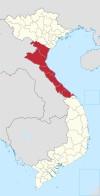North Central Coast
North Central Coast
Bắc Trung Bộ | |
|---|---|
UTC+7 (UTC +7) |
Bắc Trung Bộ (literally North Central Region, and often translated as North Central Coast) is one of the geographic
Provinces
| Province- Level Division |
Capital | Population (2022)[1] |
Area (km2)[1][2] |
|---|---|---|---|
Hà Tĩnh
|
Hà Tĩnh | 1,323,750 | 5,994.45 |
Nghệ An
|
Vinh | 3,419,990 | 16,486.49 |
Quảng Bình
|
Đồng Hới | 913,860 | 7,998.76 |
Quảng Trị
|
Đông Hà | 650,950 | 4,701.23 |
Thanh Hóa
|
Thanh Hóa | 3,722,060 | 11,114.71 |
Thừa Thiên–Huế
|
Huế | 1,160,220 | 4,947.11 |
History
Four of the northernmost provinces of the north central coast region, fell within the communist-ruled
Culture
This region features three out of
Economy
The Bắc Trung Bộ region has the second lowest
Demographics
This section needs expansion. You can help by adding to it. (June 2008) |
The monthly income for the North Central Coast is 902,900 VND compared with the whole country of 1,387,200 VND (2010).[4]
The percentage of households with permanent housing for the North Central Coast is 75.6% compared with the whole country of 49.2% (2010).[5]
The household size for the North Central Coast is 3.94 (2010).[6]
The percentage of the population aged 15 years old and over obtained the following education in the North Central Coast: Never go to school 5.2%; Primary 19.3%; Lower secondary 33.1%; Upper secondary 17.3%; College, University 5.2%; Postgraduate 0.1% (2010).[7]
The percentage of the population aged 15 years old and over work in the following industries: Agriculture 59.9%; Forestry 2.1%; Fishery 1.8%; Industry 7.5%; Construction 6.6%; Trade 7.7%; Services 14.5% (2010).[8]
Bắc Trung Bộ Region
(North Central Coast).
References
- ^ a b c d "Area, population and population density by province". General Statistics Office of Vietnam. Retrieved 12 April 2024. – Interactive table which you can view by making your selection in three boxes: (1) Cities, provinces: Select all; (2) Year: Select 2022; (3) Items: Select all.
- ^ a b Phê duyệt và công bố kết quả thống kê diện tích đất đai năm 2022 [Approve and announce the results of land area statistics in 2022] (Decision 3048/QĐ-BTNMT) (in Vietnamese). Ministry of Natural Resources and Environment (Vietnam). 18 October 2023. Retrieved 12 April 2024.
- ^ UNESCO World Heritage Centre. "Viet Nam - UNESCO World Heritage Centre". Whc.unesco.org. Retrieved 2013-06-22.
- ^ http://www.gso.gov.vn/Modules/Doc_Download.aspx?DocID=13386
- ^ http://www.gso.gov.vn/Modules/Doc_Download.aspx?DocID=13389
- ^ http://www.gso.gov.vn/Modules/Doc_Download.aspx?DocID=13382
- ^ http://www.gso.gov.vn/Modules/Doc_Download.aspx?DocID=13383
- ^ http://www.gso.gov.vn/Modules/Doc_Download.aspx?DocID=13391
16°28′N 107°35′E / 16.467°N 107.583°E

